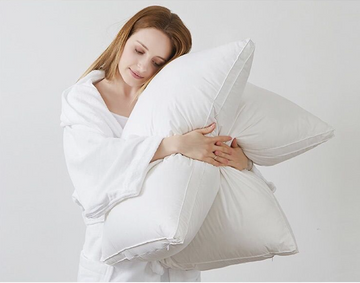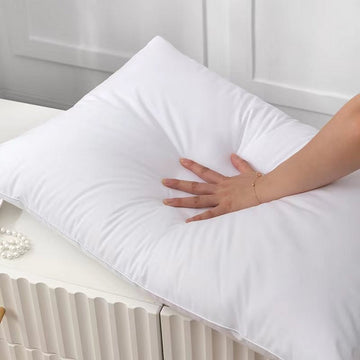Understanding the Different Materials for Sheets & Pillowcases
The Pros and Cons of Cotton, Silk, and Polyester
- Cotton: Breathable and soft, it's a popular choice for comfort. It's durable and easy to wash but can wrinkle and shrink.
- Silk: Luxurious and smooth, perfect for a cooler feel. Silk is hypoallergenic but requires careful washing and is pricey.
- Polyester: Budget-friendly and wrinkle-resistant, this material is long-lasting. However, it may be less breathable and hold more static than natural fibers.
All About Thread Count and Its Impact on Quality
Thread count measures the number of threads in a square inch of fabric. A higher thread count often means a softer and more durable sheet. But, thread count alone doesn't determine quality. The type of thread and weave also play a big role. Sheets with a count of 200-800 are common and offer a range of comfort. Remember, a very high count could result in heavier sheets. Choose based on a balance of softness, durability, and breathability.

Hypoallergenic and Organic Options for Sensitive Skin
For those with sensitive skin, choosing the right bedding is key. Hypoallergenic options reduce the risk of skin irritation and allergic reactions. Organic materials are free from harmful chemicals. They are kinder to your skin and the environment. Look for certifications like GOTS or OEKO-TEX for organic and safe textiles. Brands now offer a range of natural fibers like organic cotton, bamboo, and Tencel. These materials are gentle on the skin and offer breathability. They maintain a stable temperature throughout the night. Always read the care labels to ensure they stay gentle over time.
How to Match Sheets & Pillowcases to Your Bedroom Decor
Theme and Color Coordination Tricks
- Start by picking a color palette that complements your walls and furniture.
- Use light-colored sheets to brighten a dark room or vice versa.
- Choose a dominant shade from your decor and match your bedding to it.
- Mix and match within color families for a nuanced look but watch for clashing.
- Consider the mood you want: cool tones for a calm feel, warm for coziness.
- Don’t forget seasonal changes: lighter hues for spring/summer, richer for autumn/winter.
- Try thematic pillowcases (like nautical or floral) to add a subtle design twist.
The Role of Patterns and Designs in Bedroom Aesthetics
Patterns and designs can transform your bedroom's look. They add character and set a mood. Here are simple tips to choose the right ones:
- Simple Stripes or Plaids: For a classic, tidy look, consider stripes or plaids. They work well with most decors.
- Floral or Botanical Prints: These patterns bring a touch of nature indoors. They're perfect for a peaceful vibe.
- Geometric Shapes: If you prefer a modern space, opt for geometric patterns. They give a sleek, contemporary feel.
- Abstract Designs: For a unique touch, go with abstract patterns. They make the room more dynamic.
The key is balance. Mix and match but don't overcrowd. Aim for a design that soothes, not overwhelms. That way, your sheets and pillowcases will boost your room's aesthetic appeal.
Layering and Texture: Combining Comfort and Style
Layering and texture add depth to any bedroom. Start with a base sheet in a neutral color. Add a textured top sheet for style. Layer with a light throw or quilt for warmth. Mix textures like smooth silk and cozy cotton for comfort. Pile on pillows in various sizes and textures for a luxe feel. Don't forget a plush comforter or duvet to finish the look. Keep it all in a similar color palette for cohesion. This approach brings both comfort and style to your bedroom.
Care and Maintenance of Sheets & Pillowcases
Washing and Drying Tips for Longevity
- Always check the care label for specific instructions.
- Use mild detergent and cool water for cotton sheets.
- Wash silk with gentle soap, and avoid high heat.
- Line dry sheets when possible to preserve fibers.
- Avoid bleach and fabric softeners for all sheets.
- Shake out pillowcases before drying to minimize wrinkles.
- Iron cotton sheets for a crisp, clean look if desired.
When to Replace Your Bedding: Recognizing the Signs
- Look for visible wear and tear, like thinning fabric or holes.
- Check for faded colors or patterns that have lost their vibrancy.
- Be aware of any persistent odors even after washing.
- Notice a decrease in comfort, such as rough texture against your skin.
- Pay attention to allergic reactions which might be due to dust mites.
- Replace pillows cases more often if you have acne-prone skin.
- Set a timeline for replacement; every 2 years is a general guideline.
Storage Solutions for Your Bedding Essentials
- Always store clean: Wash your bedding before storing to avoid stains and odors.
- Choose the right location: Keep bedding in a cool, dry place away from direct sunlight.
- Use breathable containers: Cotton bags or canvas bins allow air circulation, preventing mustiness.
- Avoid plastic bags: They trap moisture and can cause mildew.
- Fold neatly: Proper folding prevents wrinkles and saves space.
- Keep sets together: Store matching sheets and pillowcases in the same container for easy access.
- Lavender sachets: Add them for a fresh scent and to deter moths.
- Rotate bedding: Use different sets regularly to ensure even wear.
- Label storage: Mark containers with contents for quick identification.






